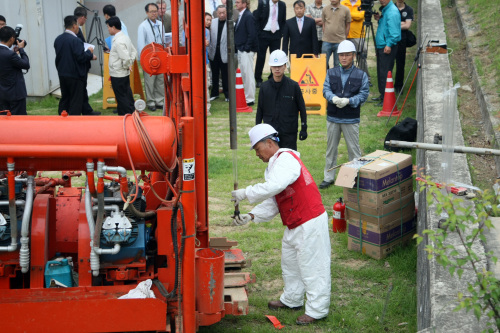Controversy over when U.S. sprayed defoliants in Korea continuesA Korea-U.S. probe team on Tuesday began taking soil samples just outside Camp Carroll, a U.S. base in Waegwan, North Gyeongsang Province where a considerable amount of Agent Orange was allegedly buried in 1978.
A separate investigation team also kicked off its first basic onsite inspection at the now-defunct Camp Mercer in Bucheon, Gyeonggi Province where a former U.S. soldier alleged that “every imaginable chemical” was buried in the 1960s.

Members of the Korea-U.S. joint investigation team take soil samples at an education and culture center near Camp Carroll in Waegwan, North Gyeongsang Province, Tuesday, where drums of Agent Orange were allegedly buried in 1978. (Yonhap News)
The investigations started with Seoul and Washington hoping to ease rising public outrage over the allegations by a series of former U.S. troops that chemicals including the toxic defoliant were buried at some of the U.S. military installations here.
The allegations have prompted public calls for a full-scale environmental inspection of all U.S. military facilities in Korea as well as the 85 sites that the U.S. returned to the Seoul government between 1990 and 2003 without environmental surveys.
Some here have also clamored for the revision of the Status of Forces Agreement to ameliorate the environmental rules in it to hold the U.S. strictly responsible for its military’s possible environmental pollution here.
The joint team consisting of some 20 people including Environment Ministry officials and U.S. military personnel gathered soil samples from an education and culture center close to Camp Carroll.
The team drilled exploratory holes at several points on the center premises until it reached the bedrock, and took soil samples there. For the next week, it plans to drill holes at 14 points near the camp.
The team also took water samples at six locations including Dongjeong Stream and Nakdong River. The samples will be sent to the country’s environmental management corporation for analysis.
“We need to take many samples here, so it would take more than two weeks to receive the analysis results,” an investigator told reporters.
The investigation inside the camp is expected to begin on Thursday after Korean and U.S. officials meet to discuss it on Wednesday. The probe team is expected to take soil samples within the camp and use ground-penetrating radar to locate the barrels of toxic chemicals allegedly buried at the camp.
The probe team already sent underground water samples it had gathered at 10 points near the camp to several local universities, including Pohang University of Science and Technology, for analysis. The analysis result is likely to come this weekend, officials said.
For the investigation inside Camp Carroll, some observers say that Korean and U.S. investigators have differing views over how to verify whether the defoliant was buried at the site.
Korean officials believe that they should conduct a thorough investigation by drilling exploratory holes and taking soil and underground water samples there, while the U.S. side seems to prefer using only radar devices to check the possible burial of Agent Orange there, observers said.
At Camp Mercer currently occupied by an engineer unit under Korean Army’s Capital Corps, the probe team consisting of military and government officials and experts, began the first basic inspection.
Examiners used “elastic waves” to find out what was underground. It is expected to find out whether the camp is contaminated or not in the middle of June, officials at the Defense Ministry said.
Meanwhile, controversy has continued over when the U.S. sprayed toxic herbicides in South Korea with the revelation of a set of conflicting U.S. government records.
Both Seoul and Washington governments have said that the U.S. military had sprayed defoliants south of the Demilitarized Zone, the buffer zone dividing the two Koreas, from 1968-69 to more easily detect North Korean infiltrations into the South.
But a compensation document that the U.S. Department of Veterans Affairs sent to a myeloma patient in November 2009, who served as a USFK troop here, stated that Agent Orange, Agent Blue and Monuron were used in Korea from 1962-70.
A former Korean soldier even testified that the U.S. sprayed a defoliant over the DMZ in the mid-1950s.
By Song Sang-ho (
sshluck@heraldcorp.com)






![[Graphic News] More Koreans say they plan long-distance trips this year](http://res.heraldm.com/phpwas/restmb_idxmake.php?idx=645&simg=/content/image/2024/04/17/20240417050828_0.gif&u=)